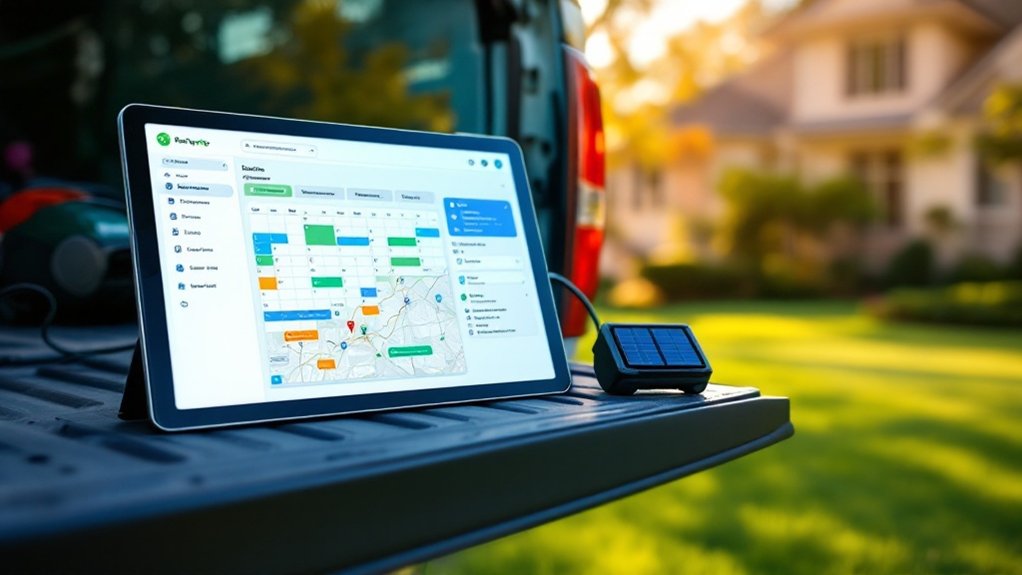Lawn care software helps small business owners manage daily operations more efficiently through integrated features for scheduling, customer management, and payment processing. Modern solutions include GPS tracking for optimized routes, automated invoicing, and detailed service histories. Cloud-based platforms enable real-time updates and improved team communication, while performance analytics help measure growth. Quality software can boost customer retention rates above 75% and reduce operational costs by 10-15%. The right digital tools reveal remarkable potential for lawn care success.
Quick Overview
- Cloud-based lawn care software offers affordable scheduling, invoicing, and customer management tools designed specifically for small business operations.
- GPS tracking and route optimization features reduce fuel costs and improve service efficiency for lawn care crews.
- Digital payment processing and automated invoicing systems help small businesses maintain steady cash flow and reduce paperwork.
- Mobile apps enable field workers to access customer information, complete digital forms, and track job progress in real-time.
- Customer relationship management features store detailed service histories, track communications, and help maintain high client retention rates.
Essential Features That Drive Lawn Care Success

While success in the lawn care industry depends on quality service and skilled workers, implementing the right software features can dramatically streamline operations and boost profitability.
Smart software solutions amplify the impact of skilled lawn care teams, turning operational efficiency into increased profits.
Modern lawn care software offers essential tools that transform daily operations:
- Scheduling and dispatching systems with GPS tracking and route optimization minimize travel time between jobs
- Client management features maintain detailed customer records and service histories
- Financial tools handle invoicing, payments, and expense tracking automatically
- Mobile accessibility lets field teams update job status in real-time
- Customer portals enable self-service booking and payment options
These core features work together to reduce manual tasks, improve customer communication, and increase operational efficiency. Software like Jobber helps businesses capture job progress with automatic payment processing, ensuring steady cash flow and reducing administrative workload.
When properly implemented, they create a solid foundation for business growth while maintaining consistent service quality.
Maximizing Business Growth Through Digital Solutions
Digital transformation in the lawn care industry opens up remarkable growth potential for businesses ready to embrace modern solutions.
Market projections indicate substantial expansion, with the global lawn care software market expected to reach $1.5 billion by 2028, growing at a 7.5% CAGR.
Small and medium-sized businesses can leverage digital solutions through:
- Cloud-based software for improved scalability
- Mobile apps for on-the-go management
- AI-powered analytics for better decision making
- IoT devices for smart equipment monitoring
The integration of these technologies drives operational efficiency and provides competitive advantages. The rising demand for real-time analytics enables service providers to make data-driven decisions for optimal resource allocation.
North American businesses, particularly in the U.S., lead adoption rates, accounting for over 50% of the market share.
Strategic partnerships with technology providers and the implementation of eco-friendly practices further enhance growth opportunities while meeting modern customer expectations.
Streamlined Operations for Better Service Delivery

Modern lawn care businesses transform their service delivery through streamlined operations that integrate technology at every touchpoint. Digital solutions enhance efficiency by automating routine tasks and improving communication between field teams and office staff. These improvements lead to better customer experiences and increased profitability. With trusted software solutions serving over 375,000 service professionals, businesses can confidently implement digital systems for their operations. Free trial periods allow companies to test various platforms before committing to a solution.
- Real-time GPS tracking and route refinement reduce travel time between jobs, allowing teams to complete more services each day while minimizing fuel costs.
- Digital forms and mobile apps eliminate paperwork, enabling technicians to access customer information, create estimates, and generate invoices instantly from the field.
- Automated scheduling and dispatch systems guarantee ideal crew management, while instant notifications keep customers informed about service status and upcoming appointments.
These operational improvements help lawn care businesses deliver consistent, high-quality service while maintaining profitable growth.
Measuring Performance and Return on Investment
Successful lawn care businesses rely on thorough performance tracking and return on investment (ROI) analysis to maximize their growth potential. Key performance indicators (KPIs) serve as essential benchmarks, with job completion rates targeting 90% and customer retention aiming for 75% or higher.
Financial metrics provide important insights into business health. Monthly recurring revenue should show steady growth, while gross profit margins above 50% indicate effective pricing strategies. Companies reviewing their KPIs on a monthly basis can improve their service efficiency by 10-15%.
Modern lawn care software makes tracking these metrics easier through integrated features like GPS tracking, automated reporting, and client portals.
Companies can make data-driven decisions by monitoring customer satisfaction scores, which should exceed 85%, and maintaining service response times under 24 hours.
Regular review of these metrics, combined with real-time data analysis, enables swift adjustments to business strategies and guarantees continued growth.
Future-Proofing Your Lawn Care Business

As the lawn care industry evolves rapidly, businesses must implement forward-thinking strategies to remain competitive and sustainable.
Modern lawn care companies are embracing technological innovations and environmental responsibility to secure their future success. By investing in advanced software solutions and adopting sustainable practices, businesses can position themselves for long-term growth. These solutions enable cost-effective operations through reduced paperwork and streamlined manual processes.
Key strategies for future-proofing include:
- Implementing AI-driven solutions for automated scheduling, route optimization, and predictive maintenance
- Shifting to eco-friendly equipment and practices to meet growing environmental consciousness
- Investing in all-encompassing software systems that integrate time-tracking, financial reporting, and customer management
These proactive measures help lawn care businesses adapt to changing market demands while building resilience against future challenges.
Early adoption of emerging technologies and sustainable practices positions companies ahead of regulatory changes and evolving customer expectations.
Frequently Asked Questions
How Long Does It Take to Train Employees on Lawn Care Software?
Training employees on software typically takes 2-4 weeks for basic proficiency, though this timeline varies based on several factors.
Prior software experience and technological comfort level can greatly impact learning speed. Most employees master essential functions within the first week, while advanced features may require additional time.
Regular practice sessions, hands-on exercises, and ongoing support help guarantee successful implementation. Periodic refresher training maintains skill levels and addresses updates.
Can Customers Pay Through Multiple Payment Platforms Simultaneously?
Like trains running on parallel tracks, multiple payment platforms can operate within a business system, but customers typically can't split a single payment across different platforms simultaneously.
While businesses can offer various payment options (Stripe, Square, etc.), customers must choose one platform per transaction. This limitation exists for security reasons and to maintain clear payment tracking.
However, customers can use different platforms for separate transactions over time.
What Happens to Stored Data if the Software Company Goes Out?
If a software company goes out of business, customer data is typically protected through several safeguards.
The company remains legally responsible for data security until it's properly transferred or deleted. Most companies have data protection protocols that include notifying customers, allowing time for data migration, and ensuring secure storage through third-party providers.
Cloud-based backups often remain accessible temporarily, giving customers time to extract their information. Legal obligations under data protection laws continue even during insolvency.
Are There Offline Capabilities When Internet Connectivity Is Poor?
Practical and purposeful offline capabilities provide reliable functionality during poor internet connectivity. Most modern software solutions include offline access features that allow users to continue working without interruption.
When connectivity is restored, data automatically synchronizes with the main system. Essential functions like client management, task tracking, and job scheduling remain available offline.
However, some advanced features like real-time GPS tracking may be limited until internet access returns.
How Often Are Security Updates and Patches Released for the Software?
Security updates and patches are released regularly, typically on a monthly schedule for standard maintenance and immediately for critical security issues.
The software automatically checks for updates daily, ensuring systems remain protected against emerging threats.
Major feature updates occur quarterly, while minor patches may be deployed weekly.
Users receive notifications when updates are available, and most patches install automatically in the background without disrupting daily operations.
Conclusion
Lawn care software isn't just changing the game – it's completely revolutionizing how small businesses operate. With astronomical productivity gains of up to 500% and customer satisfaction rates soaring through the roof, digitizing lawn care operations has become the new standard. Companies that embrace these powerful digital tools today will leave their competitors in the dust tomorrow, transforming from grass-cutting crews into unstoppable green industry titans.








